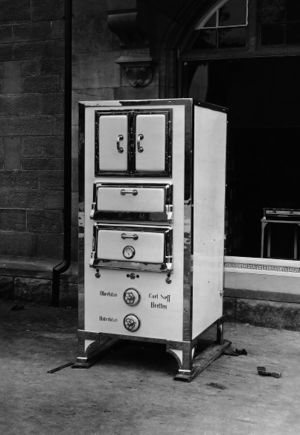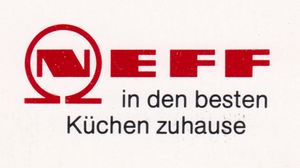The Neff Brand and the BSH Site in Bretten
With its long tradition of manufacturing kitchen appliances since 1877, NEFF joins the BSH[1] group in 1982. Over the years, NEFF grew as a premium manufacturer of ovens, extractor hoods and other kitchen appliances.
History of NEFF
Master mechanic Carl Andreas Neff founded "Carl Neff Herd und Ofenfabrik" (cooker and oven factory) in Bretten in Germany's Baden region in 1877, where he manufactured coal-fired cookers at the Zähringer Hof farmstead with the help of six companions.[2] When his sons Adolf Wilhelm and Heinrich took over the factory after his death in 1910, the workforce had expanded to 40. The portfolio now also included gas and confectionery ovens as well as commercial cookers for large-scale catering.[3] Operation and production were expanded after 1927 under the sole management of Adolf Neff. He also began to manufacture electrical appliances. The company's workforce exceeded the 100 employee mark for the first time in 1931. In the same year, Alfred Neff, the son of Adolf Neff, joined his father's company. The trademark that is still used today was registered on November 22, 1941.
The company was mandated to produce armaments in the second world war. Located away from large industrial centers, the factory built special parts for aircraft construction. Large sections of the plant were destroyed during air raids in spring 1945.
After the war, Dr Alfred Neff set about rebuilding the plant with a workforce now reduced to seven employees. The influence and contacts made when appointed Mayor of Bretten and District Administrator of the rural district of Karlsruhe in 1945 by the American occupation forces were to prove useful in his efforts to quickly restore the company. Approval to continue operating the plant was thus granted to him as early as July 15, 1945 by the US military government and on October 18, 1945 by the District Administration of Karlsruhe. Using left-over metal from the production of aircraft parts, he succeeded in carrying out makeshift repairs on the destroyed and damaged production halls, paving the way for production to commence again.
In addition to the plant in Bretten, an appliance factory had been established in the Ruiter Valley by 1957 along with a factory for large-scale kitchen equipment in Bruchsal as well as a foundry in Rinklingen. The product range was extended and modernized. In 1952, the state-of-the-art Arcus electric cooker became the most successful NEFF product of post-war production. A uniform product line from refrigerators and cookers to washing machines was successfully launched in 1955 and manufacture of chest freezers commenced. Two years later, NEFF became the first company in Europe to produce microwave ovens and in 1958 launched the first induction cooker in Europe.[4]
By the mid-sixties, some 3,000 employees were working at four plant locations of Carl Neff GmbH, which – as the largest German manufacturer of electric, coal and oil burning cookers – was exporting to just short of 50 countries.
NEFF joins forces with BSH
The company began to experience difficulties for the first time in 1965 when it took over the insolvent competitor Juncker & Ruh in Karlsruhe. Lack of investment and ultimately the end of the economic miracle with dramatically declining growth rates led to the closure of the site in 1968.[5]
To save the stricken company, Alfred Neff sold the majority of company shares in NEFF to the electronics corporation AEG. Following extensive restructuring measures, the workforce was reduced from over 4,000 to 2,300 employees and in 1971 the foundry in Bretten was closed followed by the closure of production of large-scale kitchen equipment in Bruchsal in 1979.
AEG declared bankruptcy in 1982. As a result, the Board of Management of AEG announced the liquidation of Carl Neff GmbH on August 12, 1982.[6] Following negotiations with various interested parties, a framework agreement was inked with BSH on October 1, 1982. On November 15, 1982, BSH acquired the NEFF trademark, a portion of the fixed and current assets as well as the sales companies and subsidiaries and founded what is today NEFF GmbH. Production in the parent plant in Bretten recommenced in December 1982, while sales, marketing and design were moved to BSH headquarters in Munich.
The global NEFF brand
Within BSH, NEFF specializes in cookers and extractor hoods.[7] The brand is synonymous with inspiration, pleasure and sensuous cooking experiences. The Slide&Hide® door system with rotatable door handle and retractable oven door as well as the removable TwistPad® control knob for induction cooktops were introduced in 2002.[8] The concepts were devised by a team of around one hundred developers, who were to drive the innovative strength of the Bretten-based, tradition-steeped company. In 2008, the NEFF plant in Bretten had picked up the state of Baden-Württemberg's "Environmental Prize for Businesses" in recognition of its increased energy efficiency. The digital era had reached the kitchen: a built-in oven with Home Connect function was produced in 2014.
NEFF has a strong brand core today. The Bretten-based company is known for appliance ranges that impress in terms of design, comfort and features as well as the quality of the materials and finish. The NEFF brand celebrated its 140th anniversary in 2017.
Innovations and world novelties from Bretten
| Year | Innovation |
|---|---|
| 1930 | Neff builds stoves with stone beds and electric heating |
| 1957 | Presentation of the first microwave oven in Europe |
| 1970 | Introduction of ovens with CircoTherm hot air system |
| 1986 | Introduction of the flat screen cooker hood |
| 2002 | Introduction of the revolving door handle and the fully retractable oven door Slide&Hide® and the TwistPad® removable control knob |
| 2010 | Introduction of the new VarioSteam oven steam support |
| 2014 | Built-in ovens with integrated steam and Home Connect function, Slide&Hide® and pyrolysis |
| 2016 | Production of the 25 millionth cooker hood |
| 2017 | Production of the one millionth Slide&Hide® oven |
Back to the list of BSH sites in Germany.
Notes
- ↑ BSH was founded in 1967 as Bosch-Siemens Hausgeräte GmbH - BSHG for short. In 1998, the name was changed to BSH Bosch und Siemens Hausgeräte GmbH, with the short form BSH. Since the sale of the Siemens shares in BSH to Robert Bosch GmbH the company’s name is now BSH Hausgeräte GmbH, but still BSH for short.
- ↑ BSH Corporate Archives, F-Neff-007, Peter Bahn: "Weiße Ware" – Bretten und seine Herdindustrie, Aachen 1990, page 5, 12, 16 and 18. Other companies included, for example, C. Beuttenmüller & Co., M. A. Lämle A.-G., K. W & A. Muckenfuß and Fa. Autenrieth. Ibid., page 11, 17, and from page 19, 23. The tradition-steeped cooker factory Junker & Ruh OHG in Karlsruhe is furthermore located not far from Bretten. A company was likewise founded in 1925, which was later renamed "Elektro-Gerätebau Oberweiler (E.G.O.)". Peter Bahn: "Weiße Ware" – Bretten und seine Herdindustrie, page 17, 23 and 29.
- ↑ BSH Corporate Archives, F-Neff-007, Peter Bahn: "Weiße Ware" – Bretten und seine Herdindustrie, from page 18.
- ↑ BSH Corporate Archives, F-Neff-004, Hans Tischert: 80 Jahre Neff, page 15. BSH Corporate Archives, F-Neff-005, Gabriele Kicherer: Geschichte und Bedeutung der Marke Neff, Dissertation, Aachen 1994, page 41.
- ↑ BSH Corporate Archives, F-Neff-007, Peter Bahn: "Weiße Ware" – Bretten und seine Herdindustrie, from page 29.
- ↑ "Das Geschäft bricht weg", in: Der Spiegel 27/1982, page 69.
- ↑ BSH Corporate Archives, F-Neff-007, Peter Bahn: "Weiße Ware" – Bretten und seine Herdindustrie, page 31.
- ↑ BSH Bretten Site Information Flyer, from page 6.

